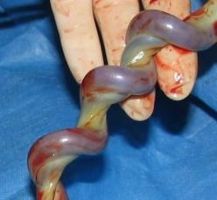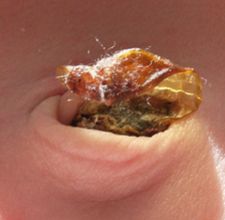|
Umbilical Cord Care Basics
The basics of umbilical cord care boil down to 3 things: keep the cord stump clean, keep the cord stump dry, and let the cord stump fall off on its own. That's it. After the cord is clamped at birth, it can be cut, and what remains is a short bit dangling from the baby's belly button. At first, the clamp will be left in place, and the cord itself will appear white gelatinous. After a few days, the clamp will be removed and the cord will start drying up. Umbilical Cord Care Tips
Umbilical Cord Care Questions What should you use to treat the cord stump? Anything? You will find conflicting advice about this. Some hospitals still advocate using rubbing alcohol to clean the gunk from between the baby's skin and the cord stump, and then sprinkling it with antiseptic powder. Some midwives and naturopaths suggest using chamomile tea or tea tree oil to clean the stump site. Recent research suggests that the stump may heal best if left alone. Can you bathe your baby? It is best to keep the umbilical cord stump dry, so sponge bathing is best, though some doctors say very brief baths are not a problem. However, since the majority of newborns don't particularly like the experience of bathing, ask yourself whether the bathing ceremony is for whose benefit? Yours or the baby's? And whether it could wait a few days until the stump falls off.
In short, yes. When it is first cut and clamped, the cord looks gelatinous and white. Then it turns yellowish green to brown to black as it dries. Its texture changes from gelatinous to that of beef jerky. Does umbilical cord care or the cutting of the cord hurt the baby? No. There are no nerves in the umbilical cord, so babies cannot feel it when it is clamped or cut. If you notice your baby cries when you are trying to clean the cord stump, this usually is because babies don't like being exposed to cold air, or the cold liquid used to clean off their stump. Does it matter how long the cord is left? No. Usual practice in hospitals is to leave less than an inch (2.5 cm), whereas some home birth midwives may leave a good 2-3 inches (5-7.5 cm). In some cases, the umbilical cord is not clamped and cut at all, but rather the baby is left attached to the placenta after birth. This is called a lotus birth. No matter how long the cord is left, it will shrivel up and fall off just the same. Umbilical Cord Care Red Flags

Umbilical Cord Care Background While in the womb, the baby receives nutrients and oxygen through the umbilical cord from the mother. The umbilical cord is attached on one end to the baby (where the belly button will be) and to the placenta at the other end. The placenta is attached to the wall of the uterus. The placenta's job is to filter the mother's blood, pass the good stuff on to the baby and bar the bad stuff from entering the baby's circulation.When the baby is born, he or she is still connected to the placenta by the umbilical cord, which allows the baby some time to adjust to having to breathe on his or her own. Because the baby is still receiving oxygenated blood through the umbilical cord, there is a gentle transition from being supported by the mother to having to breathe. It is best to wait for the umbilical cord to stop pulsating before it is clamped in order to allow the baby to receive all of his or her blood that is circulating through the placenta and the cord at the time of birth. This usually takes only 10-15 minutes. Click here to watch a video about umbilical cord care. |
 The cord stump looks like beef jerky. Is that normal?
The cord stump looks like beef jerky. Is that normal?